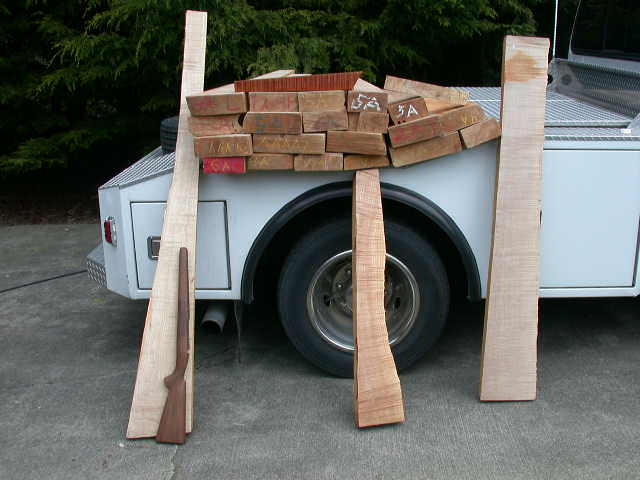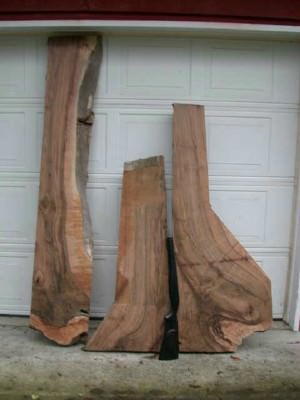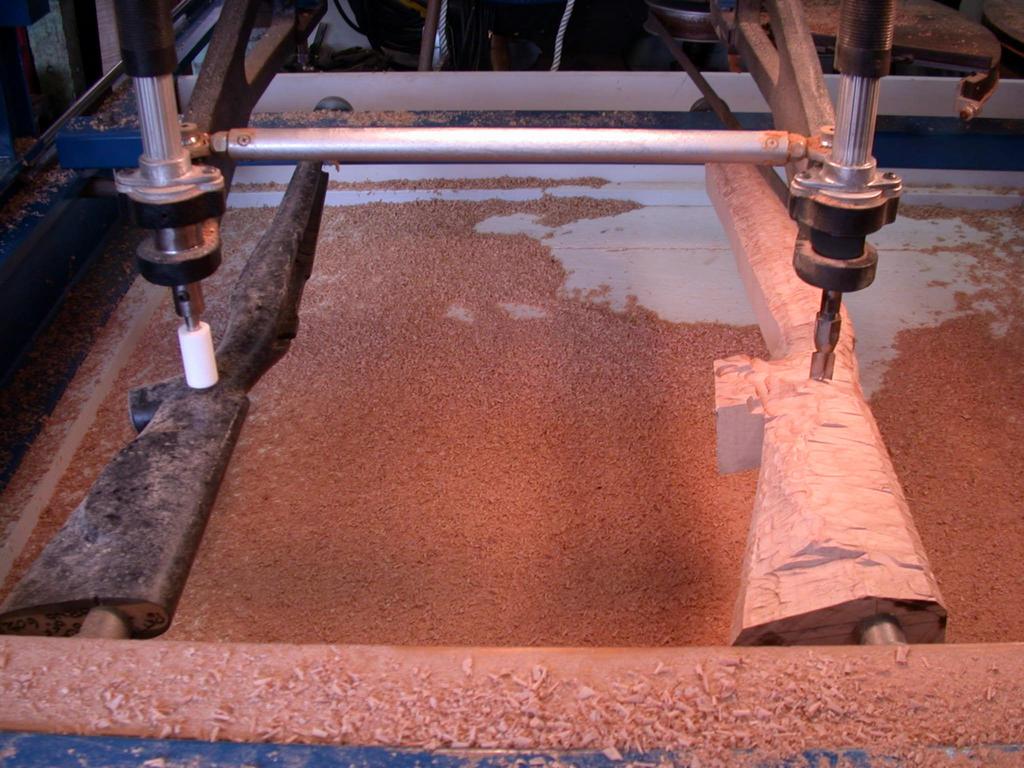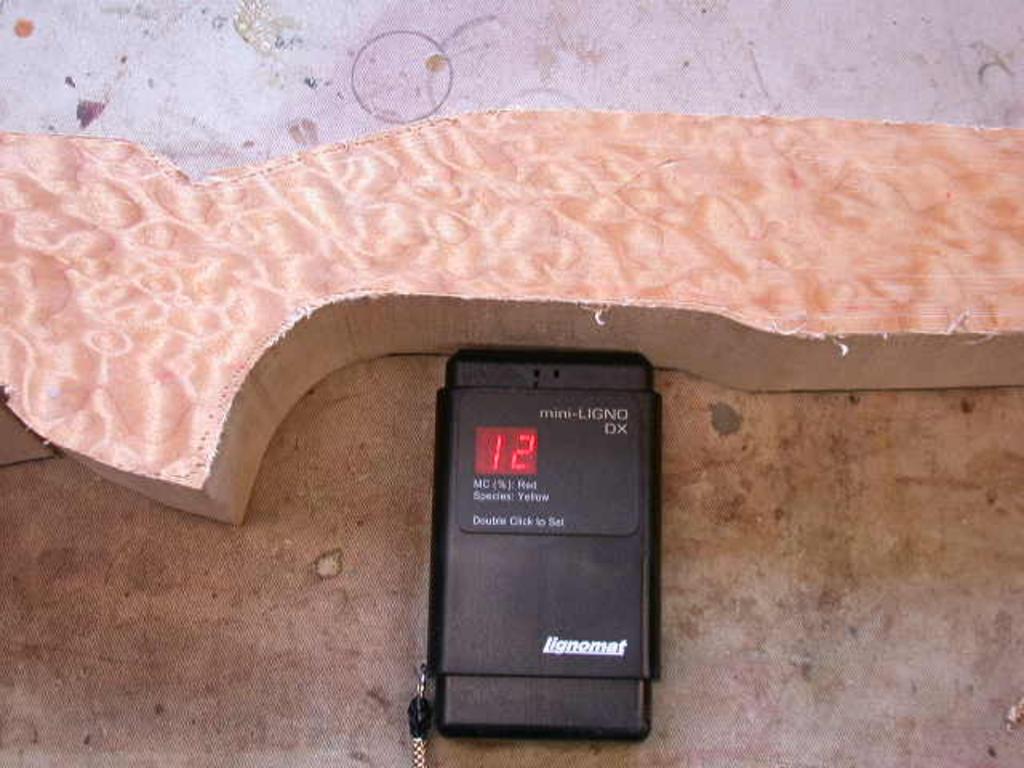You are using an out of date browser. It may not display this or other websites correctly.
You should upgrade or use an alternative browser.
You should upgrade or use an alternative browser.
What are these black spots on my wood under the glue?
- Thread starter motolife313
- Start date

Help Support Arborist Forum:
This site may earn a commission from merchant affiliate
links, including eBay, Amazon, and others.
Mold I think.
Another vote for mold. How long were the slabs dried and to to what % MC?
Wood looks like oak? Oak will stain dark when in contact with metal, but all the stains are round.
What is purpose of putting "glue" in the slab?
Wood looks like oak? Oak will stain dark when in contact with metal, but all the stains are round.
What is purpose of putting "glue" in the slab?
Common mold as we see it here often. What appears to happen for several reasons is water droplets form with mold soon after. Thanks
Ancient One
ArboristSite Operative
That is mold, you are trapping moisture beneath the glue. Water has to escape!!!
Use Anchor Seal End sealer.
Put on the ends of the slabs, not on the surface.
You want the moisture to escape through the surface and not through the ends.
I would sand all that glue off and start over by putting edge seal on the ends, then put the wood away for curing in a nice dry location away from sunlight.
Spoken from many years of curing high value gun stock blanks.
You need a moisture meter also. About as low as I can go is 11 percent, here on the wet Olympic Peninsula. The stock blanks below were cut in 1995 and are about ready for stockmaking now. Air drying is best for stock wood. Kiln drying damages the internal fibers of the blanks. Does not take as long if you are in a dry area such as Boise or Eastern Oregon.



Moisture Meter. The wood is Pacific Bigleaf Maple.

I buy Anchor Seal from Amazon:
https://www.amazon.com/gp/product/B003A08DU6/ref=ppx_yo_dt_b_asin_title_o05_s00?ie=UTF8&psc=1
Use Anchor Seal End sealer.
Put on the ends of the slabs, not on the surface.
You want the moisture to escape through the surface and not through the ends.
I would sand all that glue off and start over by putting edge seal on the ends, then put the wood away for curing in a nice dry location away from sunlight.
Spoken from many years of curing high value gun stock blanks.
You need a moisture meter also. About as low as I can go is 11 percent, here on the wet Olympic Peninsula. The stock blanks below were cut in 1995 and are about ready for stockmaking now. Air drying is best for stock wood. Kiln drying damages the internal fibers of the blanks. Does not take as long if you are in a dry area such as Boise or Eastern Oregon.



Moisture Meter. The wood is Pacific Bigleaf Maple.

I buy Anchor Seal from Amazon:
https://www.amazon.com/gp/product/B003A08DU6/ref=ppx_yo_dt_b_asin_title_o05_s00?ie=UTF8&psc=1
Ok. Thank you. I’m going to put it in my kitchen and use it as my dinner table this week. I’ll probably try using it without glue on the face. It will dry very slow in the house
Is spring or fall better to cut walnut and mill?That is mold, you are trapping moisture beneath the glue. Water has to escape!!!
Use Anchor Seal End sealer.
Put on the ends of the slabs, not on the surface.
You want the moisture to escape through the surface and not through the ends.
I would sand all that glue off and start over by putting edge seal on the ends, then put the wood away for curing in a nice dry location away from sunlight.
Spoken from many years of curing high value gun stock blanks.
You need a moisture meter also. About as low as I can go is 11 percent, here on the wet Olympic Peninsula. The stock blanks below were cut in 1995 and are about ready for stockmaking now. Air drying is best for stock wood. Kiln drying damages the internal fibers of the blanks. Does not take as long if you are in a dry area such as Boise or Eastern Oregon.



Moisture Meter. The wood is Pacific Bigleaf Maple.

I buy Anchor Seal from Amazon:
https://www.amazon.com/gp/product/B003A08DU6/ref=ppx_yo_dt_b_asin_title_o05_s00?ie=UTF8&psc=1
If you are set on using it as your kitchen table right now make sure you mount it to the base in a way that will allow the top to expand and contract as the moisture level changes... otherwise it will crack. Since it’s still wet it might also cup or twist. As the poster above says you do not seal the face only the ends, and even doing that there is no guarantee that it won’t check. If you are going to get into slab furniture look into the woodworking practice of using a “bow tie” to stop any cracks turning into the Grand Canyon. They can be a nice feature if done correctly. I don’t like wasting wood so I use them a lot.
Ancient One
ArboristSite Operative
For premium wood, like the gunstock blanks I worked with at one time, slow gentle air drying is the key.
I have 18 big Fir slabs on stickers now for air drying. Ends sealed with Anchor Seal. In a dry shed and arranged for good air circulation. I will take a look at the wood each month, reseal the ends, and make sure everything is going OK. In a year or so I will begin stabbing the slabs with the moisture meter.
Working with big milled wood takes time! It is not a fast hobby.
When we were curing the gunstock blanks we had dehumidifiers in the drying shed. Amazing how much water came out of the blanks. Buckets under the dehumidifier drains so we could keep track of the moisture coming out.
I have 18 big Fir slabs on stickers now for air drying. Ends sealed with Anchor Seal. In a dry shed and arranged for good air circulation. I will take a look at the wood each month, reseal the ends, and make sure everything is going OK. In a year or so I will begin stabbing the slabs with the moisture meter.
Working with big milled wood takes time! It is not a fast hobby.
When we were curing the gunstock blanks we had dehumidifiers in the drying shed. Amazing how much water came out of the blanks. Buckets under the dehumidifier drains so we could keep track of the moisture coming out.
Ok I’ve got most it sanded off. Does anchor seal dry clear? Anyone got pics of there ends sealed
Ancient One
ArboristSite Operative
I will take a pic and post. Put in on thin and it will dry clear. I put 3 or 4 coats on then let the slabs sit in a dry shed for a year or so.
Ok. Thank you. I’m going to put it in my kitchen and use it as my dinner table this week. I’ll probably try using it without glue on the face. It will dry very slow in the house
I hate mold in my kitchen. But they used to let meat and sausage cure , then scrape off the mold before dinner.......
Here’s the table now. I got all the mold off. Got it in Sunday night, thanks for the fast replies! I’m still thinking about putting anchor seal on the face grain or some kind of protection for the wood, I’ve got a plastic cover over it but it pulls some of the moister into the wood probably won’t matter but I’m just trying everything to take care of it, I’ve cut some apple cookies for Coasters, might router mill them flat today







Nice pictures. Cute kids, You are a lucky/blessed man!!! You'll have a helper in a few years.
Thick stuff like that needs to be stacked/stickered with weight on top while it dries. End coated to prevent checks.
A lot will depend on the how it was cut and the log cut from. That slab has no pith, some knots, and sawn a bit from the center. Leave any cover off while drying or it will cup to dry side.
Good luck on drying it.
Thick stuff like that needs to be stacked/stickered with weight on top while it dries. End coated to prevent checks.
A lot will depend on the how it was cut and the log cut from. That slab has no pith, some knots, and sawn a bit from the center. Leave any cover off while drying or it will cup to dry side.
Good luck on drying it.
It actually has the bottom still glued. Would that be bad to have that glued and the top not glued? I’m planing on leaving the plastic cover on it to protect it
It actually has the bottom still glued. Would that be bad to have that glued and the top not glued? I’m planing on leaving the plastic cover on it to protect it
If one side is sealed and the other is not, drying will be uneven. On boards that will bow and cup them. On a thick slab I'd think cupping would happen more so.
For example, leave a straight wide board outside on the ground. The bottom will pick up or stay moist and expand, the top will dry and contract. The result will be a cupped board. That's why lumber is stacked off the ground, stickered, and covered just on top layer. The ends are sealed to prevent checks. The weight of the pile and the stickers help the boards resist bows and cups as the stack dries, and airflows dries the tops and bottoms evenly. You want to dry slowly and evenly. Initaily you need good airflow to prevent mold and fungus growth.
Ends will dry much faster and that results in checks, that is why you end seal. I use Anchorseal on ends.
You might want to sand off the glue so both sides can dry evenly. Top won't dry covered with plastic, and you'll get mold/fungus as the moisture is trapped there. Might just want to have the plastic on when spills might happen, or use a tablecloth. Seal the ends.
I'm just giving my opinions from what I know. I worked in a lumber mill for a while to make money for college and learned a lot then. We cut hardwoods and softwoods. Some was dried on site, other sent to a kiln. Since I've had my own portable mill for > 20 years now.
Others might have better suggestions. I'm still learning........
P.S. You've done a great job just making that slab. Looks to be oak?
Similar threads
- Replies
- 1
- Views
- 158
- Replies
- 11
- Views
- 1K






